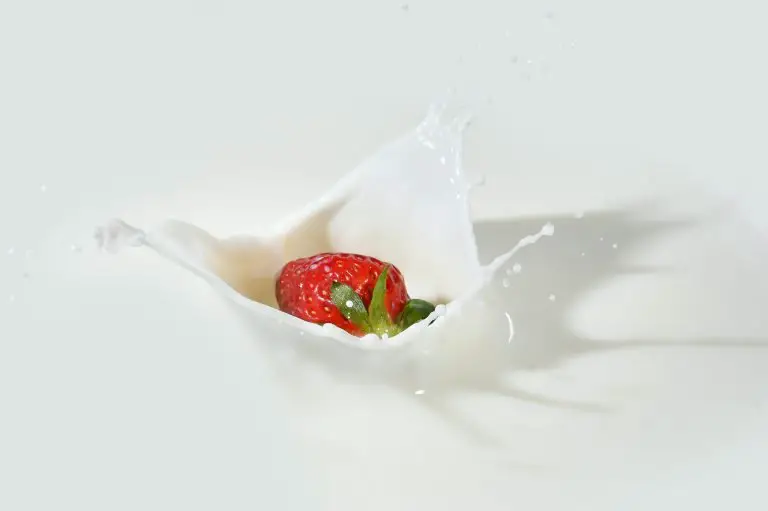Teeth staining is something that everyone experiences. It’s the result of discoloration of the outer layer of enamel on your teeth.
This is why there are so many teeth whitening products on the market, such as gels, strips, toothpaste, and more.
Additionally, your dentist may offer professional whitening services at the office.
However, some of these treatments can be costly and some contain chemicals that can be harsh on your teeth and gums.
If you want to naturally whiten your teeth without chemicals, one of your best options is to make some changes in your diet.
Certain foods are said to naturally whiten teeth; at this time, the evidence that these work is purely theoretical and anecdotal.
However, it can’t hurt to try them- they are healthy, after all. Below, we’ll name these foods and offer some explanation as to their effectiveness.
Foods that Make Teeth Whiter
Below, we’ll outline 5 foods that are believed to make teeth whiter.
Strawberries
Strawberries are known to contain malic acid, which is said to have bleaching properties that could help lighten teeth.
Additionally, strawberries increase the production of saliva for people who have dry mouths. Saliva can protect your teeth against decay, which is a common cause of discoloration by washing away food particles.
Watermelon
According to the experts, there is more malic acid in watermelons in comparison to strawberries. Again, acid could help promote the production of saliva and lighten your teeth.
Some people believe it’s the fibrous texture of watermelon that scrubs teeth, effectively removing stains. However, there’s no scientific evidence to prove this claim.
Pineapple
Your teeth are covered by a layer of salivary proteins known as pellicles. While this protects teeth, it also absorbs pigments from foods- which leads to staining of teeth. It provides a surface for bacteria to cling to and when bacteria accumulate, you end up with plaque and ultimately, tooth discoloration.
However, pineapple contains a proteolytic enzyme known as bromelain, that naturally dissolves pellicle by breaking down the proteins.
Papaya
Papaya also contains a proteolytic enzyme. It is known as papain. This enzyme is also known for breaking down protein, which breaks down the pellicle layer.
Ultimately, this reduces stains and prevents the formation and accumulation of plaque.
Milk
Milk contains lactic acid, which could potentially lighten enamel. It’s also believed that milk stimulates saliva production, which can wash away any bacteria that could cause cavities.
Milk also contains a protein known as casein, which prevents staining by recruiting calcium phosphates to prevent the accumulation of plaque and repair cavities. One study revealed that casein binds to the polyphenols in tea, which means the tannins can’t stick to teeth and stain them.
Other dairy foods may have a similar effect since they also contain casein and lactic acid.
How Long Will it Take for Foods to Whiten Teeth?
It is not clear how long it takes for foods to lighten teeth. This time there is no research on the expected timeframe. However, it is clear that when compared to commercial products, natural remedies tend to take longer.
Of course, the color of your teeth will also have an effect. If you have significant staining, it will probably take longer for you to see results.
Also, if you consume a lot of foods that will stain your teeth, whitening them will take longer.
Other Natural Remedies for Whitening Teeth at Home
In addition to adding the above foods to your diet, consider these natural remedies for whitening teeth at home.
Brush/Floss Regularly
One of the best ways to keep teeth white is to brush and floss every day.
According to experts, you should brush at least twice a day. Spend 2 minutes brushing the outer, inner, and top surfaces of your teeth. This will remove stains, debris, and bacteria that cause cavities.
Floss between teeth once a day to remove bacteria and plaque.
Use Baking Soda
One popular at-home remedy for whitening teeth is baking soda. Since it is naturally abrasive, it can mechanically remove stains.
In fact, it is commonly found in commercial whitening toothpaste.
You can make your own baking soda paste by combining equal parts of water and baking soda. Using your toothbrush, rub on teeth for 1 minute and then spit.
Use Mustard Oil and Salt
Mustard oil/salt is an Ayurvedic remedy for whitening teeth. The idea behind this is that the oil removes staining and plaque.
It can be used alone in a practice known as oil pulling, which is said to reduce bacteria and plaque.
You can add salt to enhance the whitening effect because the abrasive texture is said to mechanically remove stains.
Additionally, salt increases the pH of saliva, which can have an antibacterial effect.
To use this remedy, combine 3 parts mustard oil with 1 part salt and rub onto teeth for 1 minute before you spit.
Limit Teeth-Staining Foods
Some foods are known to stain teeth. One way to avoid additional discoloration is to avoid some of these foods and drinks. They are as follows:
- Dark berries
- Black tea
- Fruit juice
- Curry
- Red wine
- Dark cola
- Tomato-based sauces
- Coffee
- Energy drinks
If you must drink something that is known to stain teeth, use a straw to decrease the risk of staining.
Additionally, consider adding milk to your tea/coffee to decrease your risk.
Final Thoughts
As you can see, there are a few foods that have been said to whiten teeth. While it’s true that not all of these will be effective for everyone, hopefully, these ideas will give you someplace to start if you’re looking to naturally whiten your teeth.
Of course, keep in mind that simply eating the foods mentioned here is not going to give you a bright, white smile. You’ll still need to limit foods that are known to stain your teeth and practice good oral hygiene habits.

